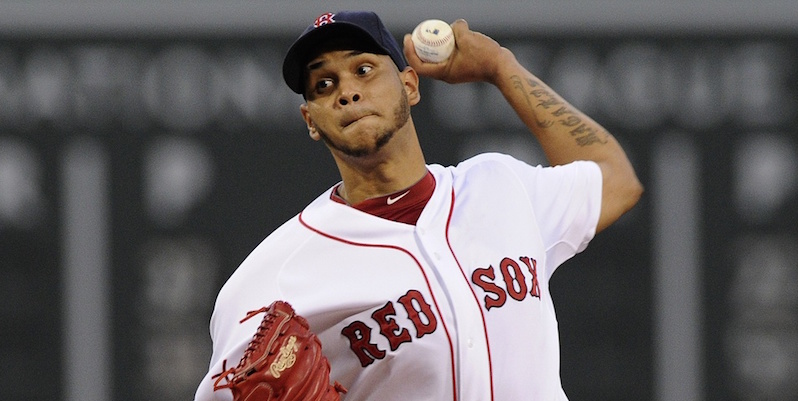Young left-handers who pump their fastball into the mid-90s often provoke warm, fuzzy feelings among baseball fans, and Eduardo Rodriguez is no exception.
Ever since Rodriguez made his major league debut in late May, he’s captivated Red Sox fans with his potential and early success in the big leagues. During a first half that saw Boston endure poor start after poor start, Rodriguez represented something of a tonic for those who had forgotten what a talented pitcher looks like.
Although he’s struggled at times in his rookie campaign, Rodriguez has done plenty to justify a spot on the team’s 2016 rotation, and has enabled Red Sox fans to dream about just how good he’ll be in his prime.
Over the first 19 starts of his career, Rodriguez has compiled a 3.94 ERA and 3.96 FIP in 109.2 innings pitched. And outside of two to three woeful starts, he’s been even better than that. In 15 of those 19 outings, Rodriguez has allowed three runs or fewer, an impressive level of consistency for a 22-year-old hurler facing major league hitters for the first time.
Still, there are aspects of Rodriguez’s performance that remain a bit puzzling. Take his strikeout numbers, for instance. Southpaws who average 94.8 mph on their fastballs don’t grow on trees, and one wouldn’t expect them to post pedestrian strikeout totals either.
Rodriguez’s strikeout rate on the season stands at 19.0%, which is below the league average of 20.3%. His swinging-strike rate (7.7%) also sits beneath the league average mark (9.8%). For one of baseball’s hardest-throwing starting pitchers, these mediocre results are baffling.
Even more surprising has been Rodriguez’s performance against left-handed hitters. So far in his young career, Rodriguez has posted stark reverse platoon splits. Lefties are batting a shocking .296/.333/.561 against him this season in 108 plate appearances. Righties, on the other hand, have hit just .240/.304/.338 versus the Venezuelan native.
So far in his young career, Rodriguez has posted stark reverse platoon splits.
So why is Rodriguez struggling to generate swings and misses? And why are lefties having so much success against him?
The answers begin with his pitch mix. Rodriguez has a tremendous fastball, one that, at its best, he can spot up and down in the zone and to either side of the plate. His changeup is also a valuable offering, but he uses the pitch far more often against righties, throwing it over 22.8% of the time, according to Brooks Baseball. Against lefties, Rodriguez’s changeup usage drops to just 8.2%, and he instead turns to his slider, which has been far less effective than either of his other two offerings.
Indeed, Rodriguez has had very little success with his slider in 2015. Opposing hitters are batting .311 with a .527 slugging percentage against the pitch, and those numbers jump even higher against lefties, who are hitting .387 with a .645 slugging percentage versus the offering.
According to FanGraphs’ pitch values, Rodriguez’s slider has been the worst in all of baseball this season (min. 100 IP).
No matter what way you spin it, Rodriguez’s slider lags behind his fastball and changeup, and succeeding in the majors with just two quality pitches is a difficult task. But how can Rodriguez find a third pitch that helps yield better results?
One intriguing idea would be for Rodriguez to try mixing a cutter into his arsenal, either by simply throwing his slider harder or using it as a different pitch altogether. A large number of pitchers have found success with cutters in recent years, most notably Shelby Miller, who similarly had two solid offerings and began using a cutter this season to give hitters a different look than his fastball.
Miller has vastly improved this year, and Rodriguez could benefit from a similar adjustment. The southpaw already has a power arsenal and just needs to find that third pitch to help give batters something else to think about.
Given his poor strikeout numbers and subpar performance against lefties, it’s clear hitters are simply sitting on Rodriguez’s fastball.
From a Red Sox perspective, the good news is that Rodriguez has still found success at the age of 22 despite these flaws. There’s little reason to feel anything but optimism about the southpaw’s future. These are the types of adjustments that nearly every young pitcher has to make, and you can be sure both the Red Sox and Rodriguez will be working hard to help fine tune that third offering come next season.
That Rodriguez has proven worthy of a spot in the club’s rotation provides cause for hope. The Red Sox have had little success developing pitchers of late, and with Rodriguez and Henry Owens showing potential in Boston this year, both look capable of giving the team valuable innings at a low cost for the next few seasons.
The Red Sox still have work to do in building their 2016 rotation, but Rodriguez will undoubtedly be a big piece of the puzzle for a staff that must improve a year from now. Considering the early promise Rodriguez has shown, he could be just an adjustment or two away from leading Boston’s rotation for years to come.
Photo by Bob DeChiara/USA Today Sports Images
